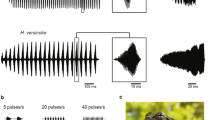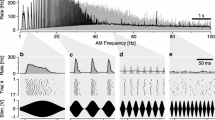Summary
Responses of neurons in the preoptic area and ventral hypothalamus to conspecific mating calls or white noise bursts were examined in male green treefrogs (Hyla cinerea) during different seasons. In the winter, 34.3% of preoptic neurons and 46.7% of ventral hypothalamic cells demonstrated significant changes in activity level during presentation of a conspecific mating call. In contrast, only 13.3% of preoptic units and 16.7% of ventral hypothalamic cells responded to the white noise. The percentage of preoptic and hypothalamic units responding to the advertisement call did not differ significantly during the summer breeding season. Type I units exhibited a dramatic increase in activity during acoustic stimulation followed by a rapid return to baseline activity levels after stimulus offset. Type II cells showed a robust activity increase during stimulation, but maintained an intermediate activity level after stimulus offset. In the preoptic area, a third response type exhibited suppressed activity during acoustic stimulation. Although seasonal condition did not alter the percentage of acoustically responsive units within either nucleus, the proportion of Type I units in the ventral hypothalamus was greatest during the summer.
Similar content being viewed by others
Abbreviations
- MC :
-
mating call
- NS :
-
no stimulus
- POA :
-
preoptic area
- VH :
-
ventral hypothalamus
- WN :
-
white noise
References
Allison JD, Wilczynski W (1991) Thalamic and midbrain auditory projections to the preoptic area and ventral hypothalamus in the green treefrog (Hyla cinerea). Brain Behav Evol 38(6): 322–331
Ball JN (1981) Hypothalamic control of the pars distalis in fishes, amphibians, and reptiles. Gen Comp Endocrinol 44:135–170
Brzoska J, Obert HJ (1980) Acoustic signals influencing the hormone production of the testes in the grass frog. J Comp Physiol 140:25–29
Dierickx K (1974) Identification of adenohypophysiotropic neurohormone producing cells in Rana temporaria. In: Knowles F, Vollrath L (eds) Neurosecretion — the final neuroendocrine pathway. Springer, Berlin Heidelberg New York, pp 170–181
Gerhardt HC (1988) Acoustic properties used in call recognition by frogs and toads. In: Fritzsch B, Ryan MJ, Wilczynski W, Hetherington TE, Walkowiak W (eds) The evolution of the amphibian auditory system. John Wiley & Sons, New York Chichester Brisbane Toronto Singapore, pp 455–509
Hall JC, Feng AS (1986) Neural analysis of temporally patterned sounds in the frog's thalamus: processing of pulse duration and pulse repetition rate. Neurosci Lett 63:215–220
Hall JC, Feng AS (1987) Evidence for parallel processing in the frog's thalamus. J Comp Neurol 258:407–419
Iela L, Pierantoni R, Rastogi RK (1980) Effect of temperature and light on androgen production in the male Rana esculenta. Experientia 36:296
Kelley DB, Morrell JI, Pfaff DW (1975) Autoradiographic localization of hormone-concentrating cells in the brain of an amphibian, Xenopus laevis. I. Testosterone. J Comp Neurol 164:47–62
Licht P, Porter D (1987) Role of gonadotropin-releasing hormone in regulation of gonadotropin secretion from amphibian and reptilian pituitaries. In: Norris D, Jones R (eds) Hormones and reproduction in fishes, amphibians, and reptiles. Plenum, New York, pp 61–85
Mesulam MM (1978) Tetramethyl benzidine for horseradish peroxidase neurohistochemistry: a non-carcinogenic blue reaction product with superior sensitivity for visualizing neural afferents and efferents. J Histochem Cytochem 26:107–117
Morrell JI, Kelley DB, Pfaff DW (1975) Autoradiographic localization of hormone-concentrating cells in the brain of an amphibian, Xenopus laevis. II. Estradiol. J Comp Neurol 164:63–78
Mudry KM, Constantine-Paton M, Capranica RR (1977) Auditory sensitivity of the diencephalon of the leopard frog Rana p. pipiens. J Comp Physiol 114:1–13
Neary TJ (1988) Forebrain auditory pathways in ranid frogs. In: Fritzsch B, Ryan MJ, Wilczynski W, Hetherington TE, Walkowiak W (eds) The evolution of the amphibian auditory system. John Wiley & Sons, New York Chichester Brisbane Toronto Singapore, pp 233–252
Neary TJ, Wilczynski W (1986) Auditory pathways to the hypothalamus in ranid frogs. Neurosci Lett 71:142–146
Penna M, Capranica RR (1984) Hormonal activation of vocalization and concomitant threshold changes in the central auditory system of the green treefrog. Soc Neurosci Abst 10:400
Pierantoni R, Minucci S, Di Matteo L, Fasano S, Varriale B, Chieffi G (1985) Effect of temperature and darkness on testosterone concentration in the testes of intact frogs (Rana esculenta) treated with gonadotrophin-releasing hormone analog (HOE 766). Gen Comp Endocrinol 58:128–130
Rastogi RK, Iela L, Saxena PK, Chieffi G (1976) The control of spermatogenesis in the green frog, Rana esculenta. J Exp Zool 196:151–166
Rastogi RK, Iela L, Delrio G, Di Meglio M, Russo A, Chieffi G (1978) Environmental influence on testicular activity in the green frog, Rana esculenta. J Exp Zool 206:49–64
Ryan MJ (1988) Constraints and patterns in the evolution of anuran acoustic communication. In: Fritzsch B, Ryan MJ, Wilczynski W, Hetherington TE, Walkowiak W (eds) The evolution of the amphibian auditory system. John Wiley & Sons, New York Chichester Brisbane Toronto Singapore, pp 637–677
Schmidt RS (1983) Neural correlates of frog calling: masculinization by androgens. Horm Behav 17:94–102
Schmidt RS (1984) Neural correlates of frog calling: preoptic area trigger of ‘mating calling’. J Comp Physiol 154:847–853
Takami S, Urano A (1984) The volume of the toad medial amygdala-anterior preoptic complex is sexually dimorphic and seasonally variable. Neurosci Lett 44:253–258
Urano A, Gorbman A (1981) Effects of pituitary hormonal treatment on responsiveness of anterior preoptic neurons in male leopard frogs, Rana pipiens. J Comp Physiol 141:163–171
Wells KD (1977) The social behaviour of anuran amphibians. Anim Behav 25:666–693
Wetzel DM, Kelly DB (1983) Androgen and gonadotropin effects on male mate calls in South African clawed frogs Xenopus laevis. Horm Behav 17:388–404
Wilczynski W, Allison JD (1989) Acoustic modulation of neural activity in the hypothalamus of the leopard frog. Brain Behav Evol 33:317–324
Yovanof S, Feng AS (1983) Effects of estradiol on auditory evoked responses from the frog's auditory midbrain. Neurosci Lett 36:291–297
Author information
Authors and Affiliations
Rights and permissions
About this article
Cite this article
Allison, J.D. Acoustic modulation of neural activity in the preoptic area and ventral hypothalamus of the green treefrog (Hyla cinerea). J Comp Physiol A 171, 387–395 (1992). https://doi.org/10.1007/BF00223968
Accepted:
Issue Date:
DOI: https://doi.org/10.1007/BF00223968




